A little history
After World War Two was over, Chenard & Walcker gave up building passenger cars and concentrated on the production of commercial vehicles. This seemed a clever move as Chenard had then an advanced design ready for production. Work on this CHT model had begun during the late Thirties, but the conflict had postponed its release. It’s finally during May 1946 that the CHT was homologated, allowing it to succeed the pre-war CKV.
Though not revolutionary – we have already seen how the Citroën TUB paved the way for modern van designs – the CHT was indeed advanced, as we said, featuring monocoque construction, front-wheel-drive, all-independent suspension and cab-forward design. On the other hand Chenard’s van didn’t benefit from a side cargo door and, more importantly, was underpowered by a tiny two-stroke, 1021 cc twin – not much for a van rated at 1500 kg! Chenard was perfectly aware of this problem, and thought a solution could be found with Peugeot’s help. Both companies were indirectly connected, the CHT’s bodies being provided to Chenard by Chausson, a Peugeot subsidiary. An agreement was signed in 1947: Peugeot would send the 1133cc usually used by its 202 model to Chenard, which was therefore able to replace its CHT by a more powerful CPV in April 1947. Bigger than the compact Chenard twin, the Peugeot four forced Chenard to alter the clean lines of its van in order to accommodate it, hence the “pig nose” for which the vehicle would become famous.
This could have seemed a smart decision at first, but it actually sealed the fate of the venerable Chenard & Walcker company. Peugeot didn’t have such a modern vehicle to counter its rival Citroën, and easily absorbed the Gennevilliers company in 1950, after almost half a century in existence. The Chenard CPV instantly became the Peugeot D3A, and received the slightly larger engine of the Peugeot 203. In 1955, the D3A became the D4A when its 1.2-litre engine was replaced by the new 1.4-litre powering the Peugeot 403, and later evolved into the D4B (I forgot most I knew about this vehicle, so I don’t remember what the difference was between the “A” and the “B”: the addition of the much-needed side cargo door perhaps?). The very last D4B was built in June 1965, and was replaced by the Peugeot J7.
A belated addition
I just notice now that the vehicle presented below as a D4A is fitted with a side cargo door – so unlike what I said above, the difference between the D4A and D4B seems to be something else. I’ll continue to look for an answer.
About the models
That’s a long time this line of vehicles cannot be seen on the roads anymore, except between the hands of collectors. There were still a few ones when I was a child, so I really wanted at least one in my collection. I had to wait for quite some time – and then many came in, all of a sudden! Interestingly, you’ll notice how popular this vehicle is among scale model collectors by the fact that the six die-casts I now have come from no less than five different makers.
Model: Chenard & Walcker CHT
Year: c.1946
Maker: Norev
Scale: 1/43
Distributed by: Atlas as no.28 of its Les petits utilitaires des années 50-60 series
Acquired: second hand with neither stand nor box, in October 2007, in Brive, France
Norev had produced this van for its “Emotion” series during the Eighties, and accepted to restart a limited run for the exclusive, subscription-only collection launched by Atlas. Most probably that’s from the latter this pleasant model comes from. A delightful piece of nostalgia on (tiny) wheels, it deserves a 14/20.


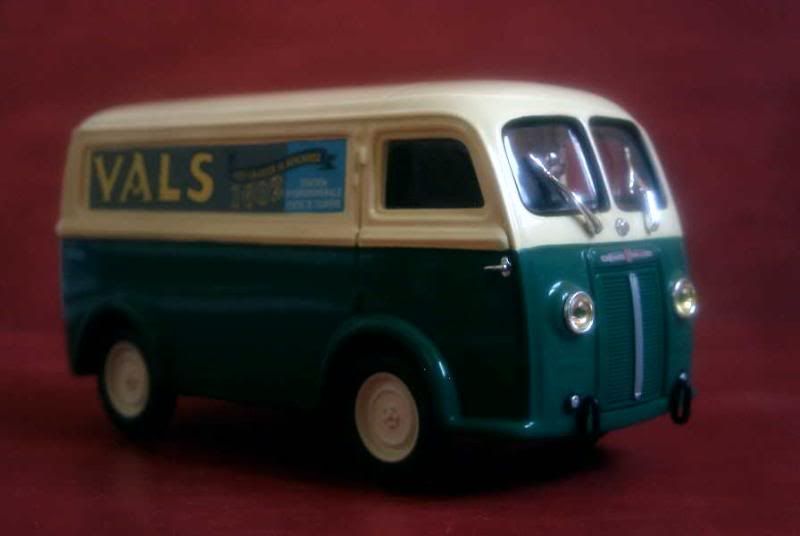
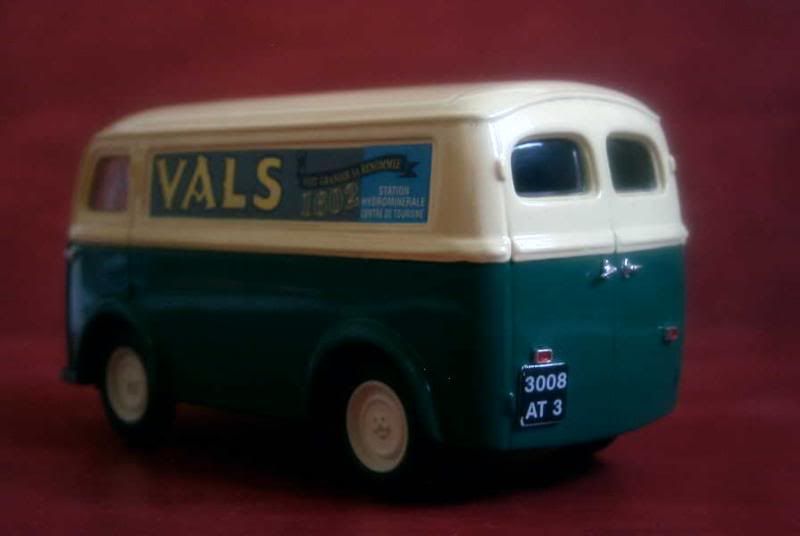
Model: Peugeot D3A
Year: c.1951
Maker: Ixo
Scale: 1/43
Distributed by: Altaya as no.4 of its Nos Chères Camionnettes d'Antan press series
Acquired: second hand with stand and box, in October 2007, through mail from a fellow collector from Rouziers de Touraine, France
Altaya couldn’t seriously distribute a series of (mostly) French commercial vehicles without including a D3/D4 in it. Ixo answered the call with a good enough D3A, sporting a nice decoration for Poulain - a powdered chocolate brand - and pleasurably reminiscent of the Dinky Toys of the old days. My rating is 12/20.
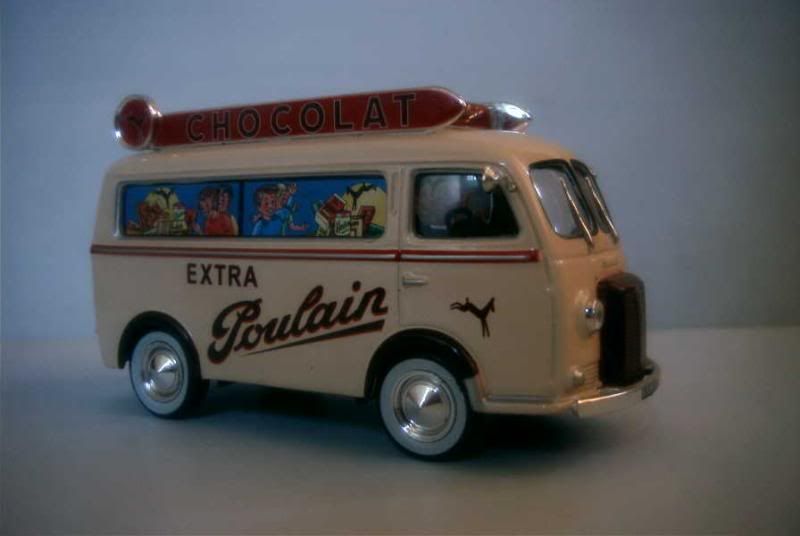


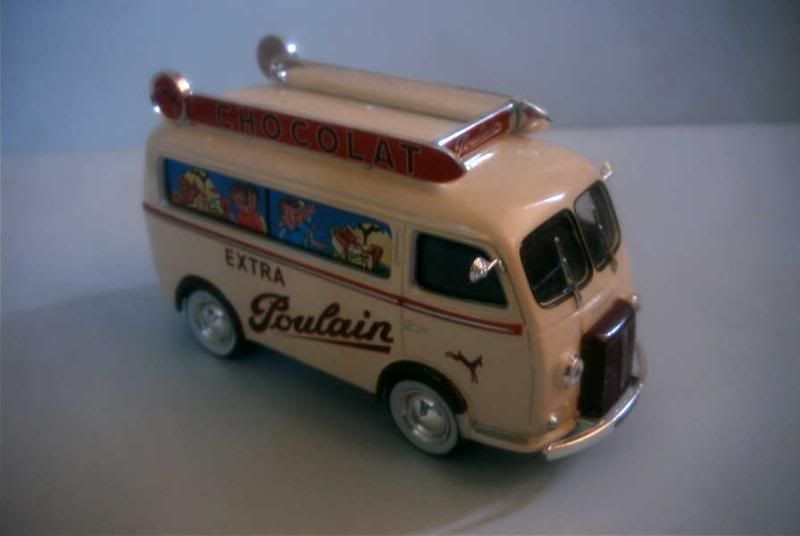
Model: Peugeot D3A
Year: c.1952
Maker: Norev
Scale: 1/43
Distributed by: Hachette as no.27 of its Collection Peugeot press series
Acquired: second hand with stand and box, in October 2007, through mail from a fellow collector from Rouziers de Touraine, France
After the Chenard van, Norev reproduces its badge-engineered successor the D3. The French die-cast maker did a good job, though the claimed year of 1961 seems dubious, first of all because I don’t think D3s have been produced after the more powerful D4 has been released, secondly for the registration numbers shown on this model actually date back to 1952. Regarding its decoration, the last time I purchased a product stamped with the laughter of the famous red cow, it was here in Manila, though imported straight from a factory in Saudia, so I don’t think an introduction to this now-globalized French cheese is necessary. My rating is 13/20.
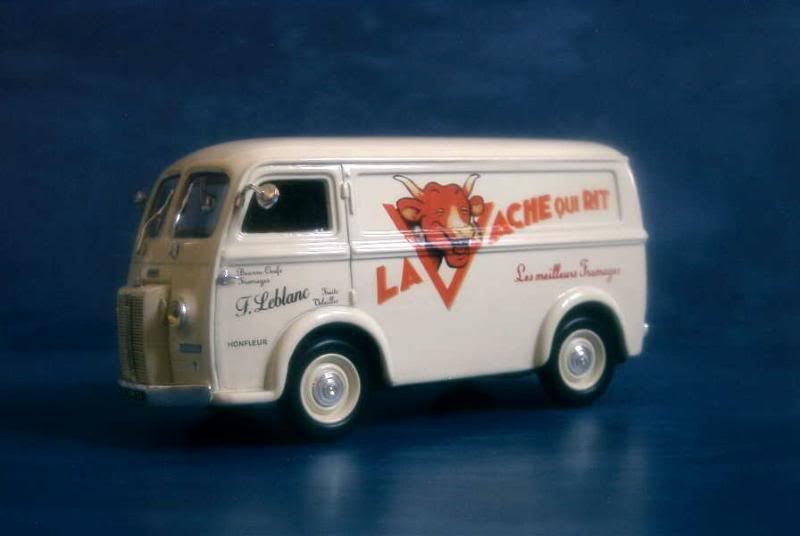
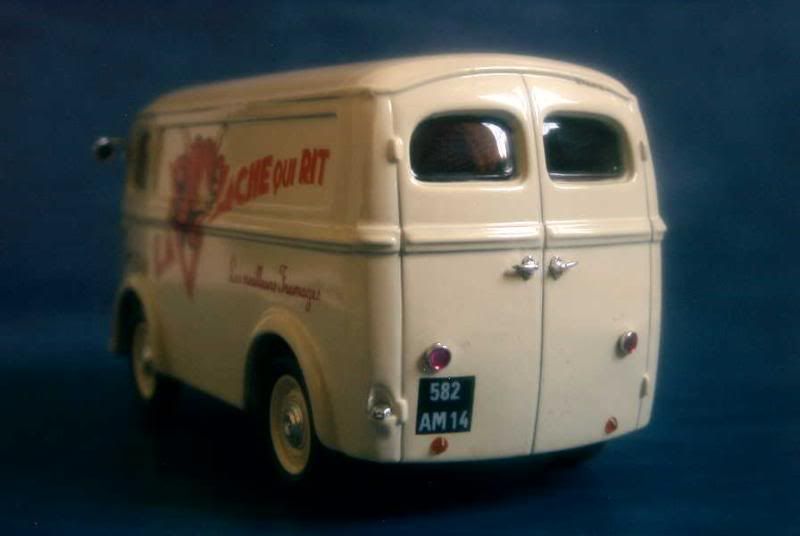
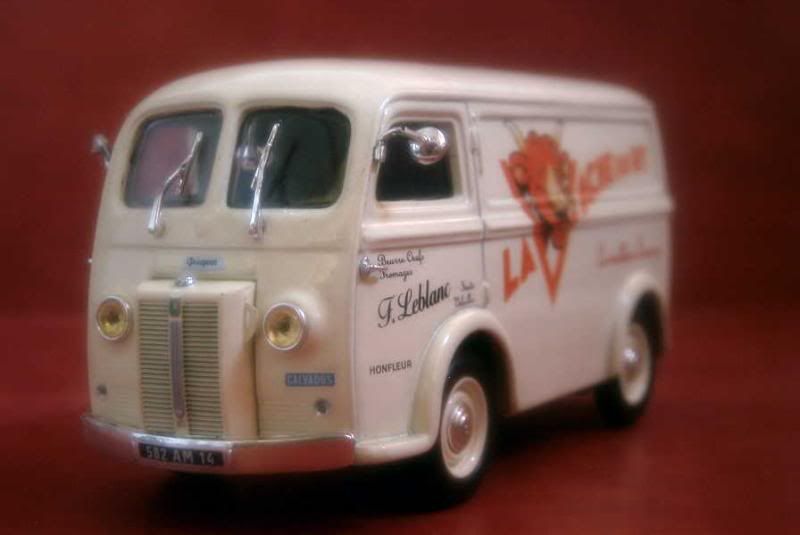
Model: Peugeot D3A
Year: c.1957
Maker: Corgi
Scale: 1/43
Distributed by: Heritage
Acquired: brand new, in January 2007, in Hong Kong, S.A.R.
Another good model, fitted with many separate parts (including photo-etched wipers) and very nicely decorated. All it takes to secure a good 14/20.


Model: Peugeot D4A
Year: c.1963
Maker: Eligor
Scale: 1/43
Distributed by: Atlas as no.6 of its Les petits utilitaires des années 50-60 series
Acquired: second hand with neither stand nor box, in October 2007, in Brive, France
A correct model, though it suffers from the comparison with its rivals described above. My rating is 11/20.

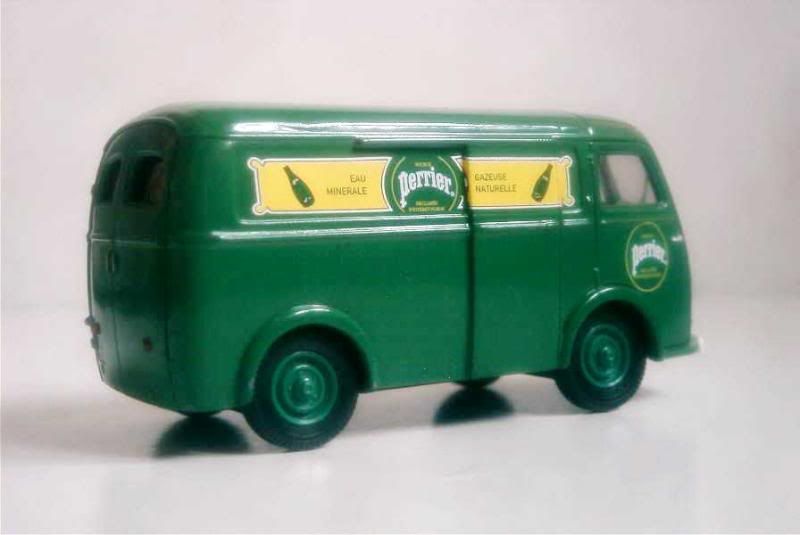
Model: Peugeot D4B
Year: 1964
Maker: Solido
Scale: 1/43
Distributed by: Hachette as no.89 or 100 of its Sapeurs Pompiers de France press series
Acquired: brand new (though unsold for long, during which its paint has seriously deteriorated), in November 2007, in Montpellier, France
Here is for JDMike’s son. As it is traditional with Solido, its version of the D4B is well proportioned, but its complete lack of details cannot conceal its age. I’d give 9/20 to it… which in no way means I’m not satisfied to have found it! Note that if I was able to identify the collection to which this model belong, I’m not sure about the issue as two different D4Bs (three actually, but the third one is pulling a trailer) have been released during its long run.
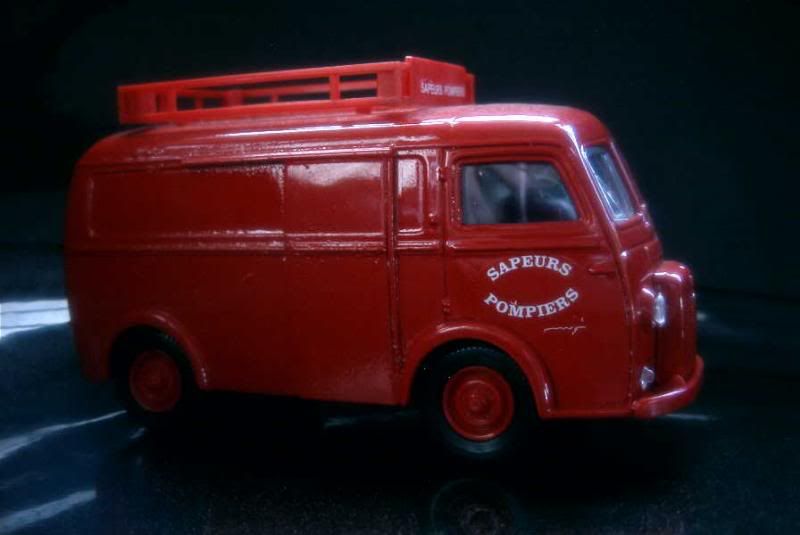
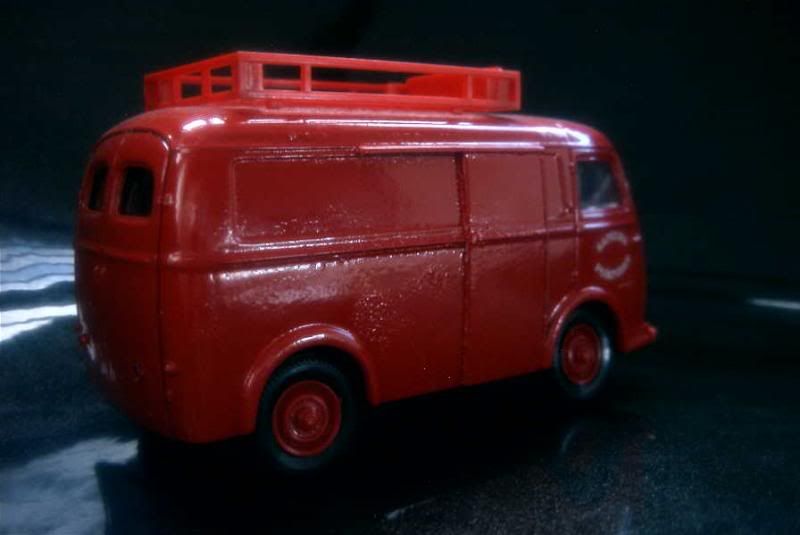
After World War Two was over, Chenard & Walcker gave up building passenger cars and concentrated on the production of commercial vehicles. This seemed a clever move as Chenard had then an advanced design ready for production. Work on this CHT model had begun during the late Thirties, but the conflict had postponed its release. It’s finally during May 1946 that the CHT was homologated, allowing it to succeed the pre-war CKV.
Though not revolutionary – we have already seen how the Citroën TUB paved the way for modern van designs – the CHT was indeed advanced, as we said, featuring monocoque construction, front-wheel-drive, all-independent suspension and cab-forward design. On the other hand Chenard’s van didn’t benefit from a side cargo door and, more importantly, was underpowered by a tiny two-stroke, 1021 cc twin – not much for a van rated at 1500 kg! Chenard was perfectly aware of this problem, and thought a solution could be found with Peugeot’s help. Both companies were indirectly connected, the CHT’s bodies being provided to Chenard by Chausson, a Peugeot subsidiary. An agreement was signed in 1947: Peugeot would send the 1133cc usually used by its 202 model to Chenard, which was therefore able to replace its CHT by a more powerful CPV in April 1947. Bigger than the compact Chenard twin, the Peugeot four forced Chenard to alter the clean lines of its van in order to accommodate it, hence the “pig nose” for which the vehicle would become famous.
This could have seemed a smart decision at first, but it actually sealed the fate of the venerable Chenard & Walcker company. Peugeot didn’t have such a modern vehicle to counter its rival Citroën, and easily absorbed the Gennevilliers company in 1950, after almost half a century in existence. The Chenard CPV instantly became the Peugeot D3A, and received the slightly larger engine of the Peugeot 203. In 1955, the D3A became the D4A when its 1.2-litre engine was replaced by the new 1.4-litre powering the Peugeot 403, and later evolved into the D4B (I forgot most I knew about this vehicle, so I don’t remember what the difference was between the “A” and the “B”: the addition of the much-needed side cargo door perhaps?). The very last D4B was built in June 1965, and was replaced by the Peugeot J7.
A belated addition
I just notice now that the vehicle presented below as a D4A is fitted with a side cargo door – so unlike what I said above, the difference between the D4A and D4B seems to be something else. I’ll continue to look for an answer.
About the models
That’s a long time this line of vehicles cannot be seen on the roads anymore, except between the hands of collectors. There were still a few ones when I was a child, so I really wanted at least one in my collection. I had to wait for quite some time – and then many came in, all of a sudden! Interestingly, you’ll notice how popular this vehicle is among scale model collectors by the fact that the six die-casts I now have come from no less than five different makers.
Model: Chenard & Walcker CHT
Year: c.1946
Maker: Norev
Scale: 1/43
Distributed by: Atlas as no.28 of its Les petits utilitaires des années 50-60 series
Acquired: second hand with neither stand nor box, in October 2007, in Brive, France
Norev had produced this van for its “Emotion” series during the Eighties, and accepted to restart a limited run for the exclusive, subscription-only collection launched by Atlas. Most probably that’s from the latter this pleasant model comes from. A delightful piece of nostalgia on (tiny) wheels, it deserves a 14/20.




Model: Peugeot D3A
Year: c.1951
Maker: Ixo
Scale: 1/43
Distributed by: Altaya as no.4 of its Nos Chères Camionnettes d'Antan press series
Acquired: second hand with stand and box, in October 2007, through mail from a fellow collector from Rouziers de Touraine, France
Altaya couldn’t seriously distribute a series of (mostly) French commercial vehicles without including a D3/D4 in it. Ixo answered the call with a good enough D3A, sporting a nice decoration for Poulain - a powdered chocolate brand - and pleasurably reminiscent of the Dinky Toys of the old days. My rating is 12/20.




Model: Peugeot D3A
Year: c.1952
Maker: Norev
Scale: 1/43
Distributed by: Hachette as no.27 of its Collection Peugeot press series
Acquired: second hand with stand and box, in October 2007, through mail from a fellow collector from Rouziers de Touraine, France
After the Chenard van, Norev reproduces its badge-engineered successor the D3. The French die-cast maker did a good job, though the claimed year of 1961 seems dubious, first of all because I don’t think D3s have been produced after the more powerful D4 has been released, secondly for the registration numbers shown on this model actually date back to 1952. Regarding its decoration, the last time I purchased a product stamped with the laughter of the famous red cow, it was here in Manila, though imported straight from a factory in Saudia, so I don’t think an introduction to this now-globalized French cheese is necessary. My rating is 13/20.



Model: Peugeot D3A
Year: c.1957
Maker: Corgi
Scale: 1/43
Distributed by: Heritage
Acquired: brand new, in January 2007, in Hong Kong, S.A.R.
Another good model, fitted with many separate parts (including photo-etched wipers) and very nicely decorated. All it takes to secure a good 14/20.


Model: Peugeot D4A
Year: c.1963
Maker: Eligor
Scale: 1/43
Distributed by: Atlas as no.6 of its Les petits utilitaires des années 50-60 series
Acquired: second hand with neither stand nor box, in October 2007, in Brive, France
A correct model, though it suffers from the comparison with its rivals described above. My rating is 11/20.


Model: Peugeot D4B
Year: 1964
Maker: Solido
Scale: 1/43
Distributed by: Hachette as no.89 or 100 of its Sapeurs Pompiers de France press series
Acquired: brand new (though unsold for long, during which its paint has seriously deteriorated), in November 2007, in Montpellier, France
Here is for JDMike’s son. As it is traditional with Solido, its version of the D4B is well proportioned, but its complete lack of details cannot conceal its age. I’d give 9/20 to it… which in no way means I’m not satisfied to have found it! Note that if I was able to identify the collection to which this model belong, I’m not sure about the issue as two different D4Bs (three actually, but the third one is pulling a trailer) have been released during its long run.





4 comments:
It's my first time to see ths Peugeot van and I'm loving it. thanks for the photos and for the history.
Thanks for your comments Jovet and welcome. :)
Hello, again!
Fantastic Vans! They are lovely...
Nice words from a great movie (Casablanca), to me one of tne best ever made.
Always glad to have you among us José António. Thank you for your kind comments.
Oh so you read my answer to your previous comment, don't you? I'd be embarassed to give less then tens and tens of titles if I'd been asked about the greatest movie of all times, but Casablanca would certainly be among them.
Post a Comment